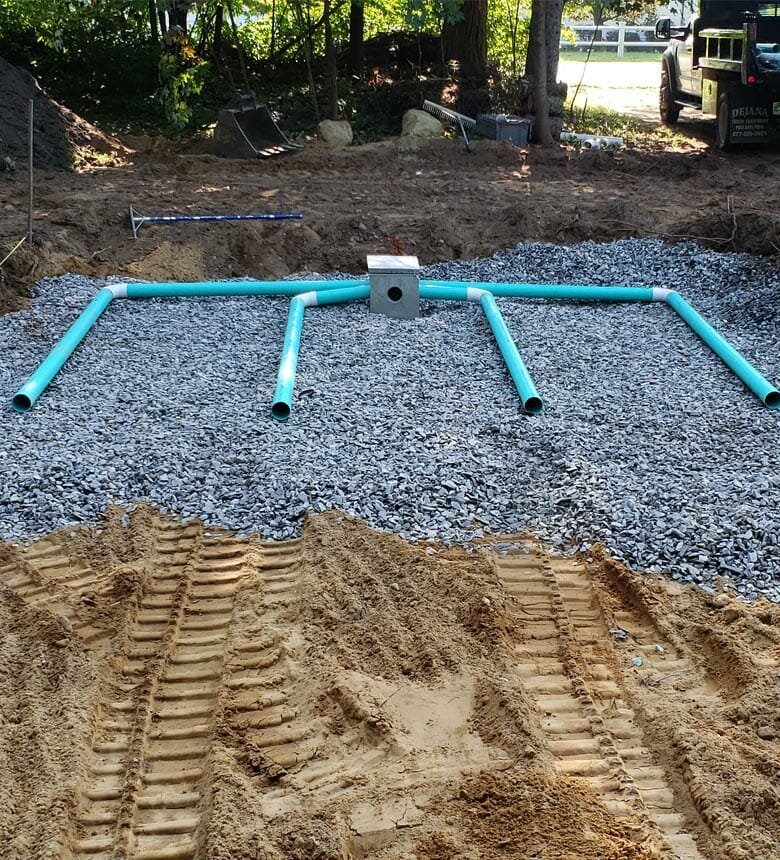When planning septic design Dundalk it’s vital to follow Ontario regulations, optimize for local soil conditions, and rely on professional engineering expertise. This article guides residents and builders through key aspects of septic system design tailored to Dundalk’s rural context, emphasizing compliance, environmental protection, and cost‑effectiveness.
Understanding Septic System Fundamentals in Dundalk
A conventional septic system consists of a multi‑chamber tank and a leaching bed where treated wastewater filters into the soil. In Ontario the septic tank must include at least two compartments and contain enough volume—typically no less than three thousand six hundred litres or twice the daily sewage flow—which ensures proper settling and treatment.
Regulatory Framework with the Ontario Building Code
Septic system projects must adhere to Part 8 of the Ontario Building Code which sets requirements for design, installation, tank size, location clearances and maintenance obligations. The code mandates compartment sizes, depth, risers and safe access for maintenance.
Site Evaluation and Soil Testing for Dundalk Settings
Before designing a system residents must assess soil permeability, groundwater level, and topography through percolation tests and site evaluation. These assessments determine whether a conventional system suits the site or if alternative solutions like mound systems or aerobic treatment units are needed.
System Sizing and Component Requirements
The septic tank must accommodate peak wastewater flows and support sludge settlement while distributing effluent to the leaching bed. According to Ontario code, the first compartment must hold at least 1.3 times daily flow and at least 2 400 litres, with additional compartments sized at least 50 percent of the first.
Permit Process in Dundalk and Southgate Township
Installing or replacing a septic system in Dundalk requires a building permit from the Township of Southgate. Installations must meet zoning and Building Code requirements, and design submissions must accompany permit applications. The permit process includes submission, inspections and final municipal approval.
Who Is Qualified to Design Your Septic System
Only licensed professionals may design septic systems in Ontario. They include PEO-certified professional engineers, architects working in their fields of expertise, BCIN‑registered designers, and installers designing only for their own projects. Hiring a qualified expert ensures code compliance, liability protection and efficient permitting.
Alternative Septic Systems for Challenging Dundalk Sites
When soil conditions or lot constraints prevent conventional systems, the design may require alternative solutions. Aerobic treatment units, mound systems, and peat‑based filters offer advanced treatment in tight or poorly draining environments. These systems require specialized design and approval.
Septic System Components and Operation
A typical septic system features a durable, watertight tank made of concrete or poly material with inlet and outlet baffles or tees to segregate solids. The tank features effluent filters and access risers for maintenance. Effluent flows from the tank into a gravel‑filled leaching bed where filtration by soil microbes occurs.
Role of Elmid Design Inc in Septic Design Dundalk
Elmid Design Inc, certified by Professional Engineers Ontario (PEO), provides septic system design, permit submissions, and engineering oversight tailored to Ontario’s code. The firm specializes in rural septic systems, helping clients in Dundalk navigate regulations and secure approvals efficiently.
Achieving Google E‑A‑T Through Professional Design
Trust in septic system design grows when residents see expertise, ethical service, and regulatory authority. Hiring a PEO‑certified firm reinforces trust, ensures accurate designs, and supports responsible environmental stewardship, all aligned with Google’s E‑A‑T principles.
Inspection, Maintenance and Long‑Term Performance
After installation, systems must be inspected regularly—typically every three to five years—though this may vary by usage level. Maintenance includes pumping to prevent sludge build‑up and monitoring drain field absorption. Early detection of issues like pooling water or odors can avert failures and costly replacement.
Local Support for Dundalk Homeowners
Dundalk residents can consult nearby licensed installers or engineers for design and installation. While general directories list many providers, working with an Ontario‑certified septic designer with local knowledge ensures compliance and tailored solutions.
Final Thoughts on Septic Design Dundalk
Designing a septic system in Dundalk demands careful planning, qualified design, regulatory knowledge, environmental awareness, and maintenance planning. Collaborating with Elmid Design Inc ensures safe, efficient, and compliant on‑site wastewater solutions in rural Ontario.

Local Soil Considerations for Septic Design in Dundalk
When you plan septic design Dundalk you must evaluate soil conditions with precision. Local degradability depends on texture permeability and layer depth. Registered engineers perform percolation tests and classify soil according to the Ontario Building Code. That testing reveals the “T time,” which reflects how quickly water percolates. Dundalk soils may contain loam or clay with higher T times, requiring larger or alternative systems. Engineers rely on those findings to determine suitable septic options and ensure safe, functional designs.
Designing Septic Tanks According to Ontario Code
Septic design Dundalk must comply with Ontario Building Code Part 8. The first tank compartment must hold at least 1.3 times daily sewage flow but no less than 2400 liters. The total capacity must be at least 3600 liters. Designers connect compartments in series and ensure outlet piping slopes at least two percent. That configuration reduces solids carry‑over and optimizes treatment before effluent reaches the drain field.
Permit Requirements from Southgate Township
Dundalk falls under Southgate Township and septic work triggers a building permit. Installation or repair of systems, tanks or beds must receive permit approval before construction begins. That rule protects local water and ensures compliance with Ontario regulations. You submit design plans via Cloud permit, and inspections follow during installation and after completion.
Alternative Systems for Challenging Ground
When conventional systems fail due to high groundwater or poor soil, multiple alternatives offer solutions. Biofilters use organic or synthetic media like peat or coconut husk to treat effluent passively before it reaches the drain field. These units suit small lots or impermeable soils. Advanced systems may include aerobic treatment and mound designs depending on site constraints. The choice depends on detailed soil evaluation and regulatory approval.
Installing Safety Measures According to Standards
Modern septic design must follow updated safety standards for tank openings. The Canadian National Standard B66‑21 now requires secondary screens on access risers over 200 millimeters in diameter. That measure protects against accidental falls into the tank, ensures safer tank maintenance, and aligns with current safety best practices. You ensure compliance by specifying screened risers in design drawings.
Long‑Term Maintenance and Homeowner Responsibility
Once your system functions, you plan for maintenance and longevity. Homeowners must schedule inspections and pumping regularly. Ontario guidelines suggest pumping every three years for an average residential tank serving four people. That schedule prevents solids from entering the drain field and prolongs system life. You should also monitor for signs of failure such as slow drainage or odors and have a licensed technician inspect if issues arise.
Building Trust and E‑A‑T Through Professional Engineering
Dundalk residents benefit from working with certified professionals. A PEO‑licensed engineer brings expertise and accountability to septic design Dundalk. That credential strengthens trust, supports accurate compliance with code and settlement of permit processes, and reflects high standards. It demonstrates expertise, authority and trustworthiness in line with Google’s E‑A‑T guidelines. Elmid Design Inc exemplifies this standard in septic system projects throughout Ontario.
Environmental Impact of Poor Septic Design in Dundalk
Improper septic systems can contaminate groundwater, affect streams and harm ecosystems in rural Dundalk. Incomplete treatment of wastewater allows bacteria, nitrates and phosphates to enter water sources. Over time this leads to algae blooms, soil contamination and degraded habitat. That’s why septic design must factor in distance from wells, streams and property lines. With precise engineering and proper tank sizing, you prevent leakage and support long‑term environmental protection.
How to Upgrade Failing Septic Systems Legally
If your system shows signs of failure—such as soggy drain fields or odors—you cannot simply repair it without meeting Ontario Building Code standards. You must request a site evaluation and design a replacement system that resolves code deficiencies. That redesign requires professional engineering oversight and a new building permit from Southgate Township. You avoid fines and environmental hazards by hiring certified designers and submitting compliant plans through official channels.
Septic Design for New Construction in Dundalk
Building a home in Dundalk with no municipal sewer means you need a properly designed septic system before construction begins. Site plan approval typically requires a complete septic design package including system type, tank sizing, and leaching bed layout. Soil conditions and property slope affect what’s allowed. Only licensed professionals may submit the design as part of your permit application. That sequence helps streamline approvals and avoids delays during the build.
The Role of Engineering Reports in Permits
Engineered septic designs often include a stamped design report outlining flow calculations, tank specifications, and soil testing data. Southgate Township and other municipalities rely on those reports to confirm your project meets the Building Code. The report documents how designers sized the system and why specific methods were chosen. When completed by licensed engineers like those at Elmid Design Inc, these reports offer clarity, support permit approval and ensure inspection success.
Reducing Future Costs Through Smart Design
A well‑engineered septic system saves homeowners money in the long run. Proper sizing prevents early failure, while correct placement avoids costly excavation or relocation. Advanced treatment systems, although more expensive initially, often extend drain field lifespan and require less frequent pumping. Designing with access risers, screened lids and easy maintenance points also reduces future service costs. That proactive planning protects both your investment and your property.
Working with Elmid Design Inc for Septic Design Dundalk
Elmid Design Inc has a Certificate of Authorization from Professional Engineers Ontario, allowing them to design septic systems across the province including Dundalk. Their team delivers site assessments, engineered design drawings and permit submissions tailored to the Ontario Building Code. With local experience and regulatory expertise, they simplify the septic design process for homeowners, builders and contractors. Choosing Elmid ensures safety, efficiency and smooth project approval.
Seasonal Challenges for Septic Design in Dundalk
Cold weather presents unique challenges for septic design in Dundalk. Freezing temperatures can affect tank access, effluent lines and soil permeability. Designers must insulate tanks, install risers with sealed lids and bury piping below frost lines to maintain system integrity during winter. Snow and ice accumulation can also interfere with surface drainage around the leaching bed. Proper grading and frost-proof construction protect the system year-round. Planning for seasonal conditions prevents freezing, cracking and system backups, ensuring continuous performance across all months in Ontario’s cold climate.
Greywater and Blackwater Considerations
Ontario regulations distinguish between blackwater from toilets and greywater from sinks, showers and laundry. In a standard septic system, both streams flow into the same tank for treatment. However, designers can separate greywater where allowed, diverting it to filtration beds or treatment units for reuse or safe dispersal. This approach reduces load on the main system and extends leaching bed lifespan. While greywater reuse is less common in Dundalk, engineers assess site conditions to decide whether separation improves efficiency or compliance in rural septic design.
Soil Absorption Trench Design
The soil absorption trench, or leaching bed, disperses treated effluent into the ground. Its effectiveness depends on trench size, depth, spacing and soil permeability. Ontario Building Code specifies minimum trench lengths based on the site’s percolation test results, known as the “T-time.” Designs must provide enough surface area to handle peak flow without overloading the soil. In Dundalk, engineers often face loamy or silty soils with slow permeability, which require wider beds or additional lines. Designs account for slope, setbacks and surface drainage to ensure long-term performance.
Leaching Bed Setbacks and Slope
Regulations require that leaching beds maintain specific setbacks from property lines, wells, buildings and water bodies. In Dundalk, setbacks ensure groundwater protection and system safety. Designers must consider site slope when laying out beds, maintaining at least a 1.5-meter clearance to groundwater and ensuring effluent flows downhill without surface pooling. Grading often needs adjustment to guide water away from the field. Following precise setback requirements prevents contamination and meets Ontario Building Code standards. Neglecting slope or spacing during design can cause serious system failures.
Future-Proofing Septic Design for Dundalk Properties
Homeowners planning future property expansions need scalable septic solutions. If you may add bedrooms or outbuildings, the initial system must allow for increased flow. Designers future-proof systems by oversizing tanks, laying additional piping, or installing treatment units that simplify future upgrades. This reduces the need for redesign or full replacement later. Anticipating future use lowers long-term costs and makes additions easier. Dundalk residents often expand rural homes over time, so considering growth at the design stage is a smart move that saves time and avoids regulatory issues.
Frequently Asked Questions
What size septic tank do I need for a Dundalk home?
The Ontario Building Code requires a minimum of 3600 litres total capacity and the first compartment must be at least 2400 litres or 1.3 times the daily sewage flow, whichever is larger. A licensed designer calculates this based on fixture count and usage.
Do I need a permit for septic tank replacement in Dundalk?
Yes, all septic installations or replacements in Dundalk require a building permit issued by Southgate Township. You must submit engineered design drawings and receive inspections before using the system.
Can I design my own septic system?
Only qualified professionals may design septic systems under Ontario regulations. That includes professional engineers like those at Elmid Design Inc, BCIN‑registered designers or licensed installers designing for their own properties.
What are the signs my septic system is failing?
Common signs include slow drains, sewage odors, wet spots around the drain field or tank and backups inside the home. If you notice any of these, hire a licensed septic inspector immediately.
How much does septic design cost in Dundalk?
Costs vary depending on site complexity, soil type and system choice. Simple conventional designs may range from $1,500 to $3,000 for engineering. More advanced systems with treatment units can exceed $5,000 including site evaluations and permitting.

Why Dundalk Trusts Elmid Design Inc for Septic Design
Elmid Design Inc is a licensed engineering firm with a Certificate of Authorization from Professional Engineers Ontario, specializing in septic design across rural Ontario including Dundalk. Their team delivers code-compliant, site-specific solutions that meet all regulatory requirements under the Ontario Building Code. Known for precision, expertise and timely permit approvals, Elmid Design Inc helps homeowners, builders and contractors avoid costly delays and ensure long-term system performance. Their proven track record in septic design Dundalk makes them the trusted choice for reliable, engineered wastewater solutions.
Geographic Locations That We Service:
Our Licensed Professional Engineers specializing in Engineered Site Grading Plans offer the best-engineered site grading plan, lot grading and erosion plan, and drainage plan to obtain site plan approval and building permits in Ontario, including a wide range of municipalities. Each area boasts unique features and requirements, making our tailored approach essential for success.
Toronto and Surrounding Areas
In the vibrant heart of Ontario, we service Toronto (City of Toronto) and surrounding areas. Additionally, we cover Oshawa (City of Oshawa), Pickering (City of Pickering), and Clarington (Municipality of Clarington). Furthermore, our expertise extends to Ajax (Town of Ajax), Whitby (Town of Whitby), Brock (Township of Brock), Scugog (Township of Scugog), and Uxbridge (Township of Uxbridge).
Halton Region
Moving to the Halton Region, our services encompass Burlington (City of Burlington) and Halton Hills (Town of Halton Hills). Also included are Milton (Town of Milton) and Oakville (Town of Oakville).
Peel Region
In the Peel Region, we provide services in Brampton (City of Brampton), Mississauga (City of Mississauga), and Caledon (Town of Caledon).
York Region
Our services in the York Region cover Vaughan (City of Vaughan), Aurora (Town of Aurora), and East Gwillimbury (Town of East Gwillimbury). We also cater to Georgina (Town of Georgina), Markham (City of Markham), Newmarket (Town of Newmarket), Richmond Hill (City of Richmond Hill), Whitchurch-Stouffville (Town of Whitchurch-Stouffville), King (Township of King), and Bradford-West Gwillimbury (Town of Bradford-West Gwillimbury). Each municipality here offers a distinct setting, requiring our specialized approach.
Other Southern Ontario Cities and Towns
We also serve many other cities and towns in Southern Ontario. These include Hamilton (City of Hamilton), St. Catharines (City of St. Catharines), Niagara on the Lake (Town of Niagara on the Lake), Brant (County of Brant), Cambridge (City of Cambridge), Kitchener (City of Kitchener), Waterloo (City of Waterloo), and Woodstock (City of Woodstock). Furthermore, we operate in Guelph (City of Guelph), Centre Wellington (Township of Centre Wellington), Shelburne (Town of Shelburne), Orangeville (Town of Orangeville), New Tecumseth (Town of New Tecumseth), Essa (Town of Essa), Collingwood (Town of Collingwood), Wasaga Beach (Town of Wasaga Beach), Barrie (City of Barrie), Midland (Town of Midland), Orillia (City of Orillia), Ramara (Town of Ramara), Minden Hills (Town of Minden Hills), North Kawartha (Town of North Kawartha), Kawartha Lakes (City of Kawartha Lakes), Peterborough (City of Peterborough), Selwyn (Town of Selwyn), and Brighton (Municipality of Brighton).




